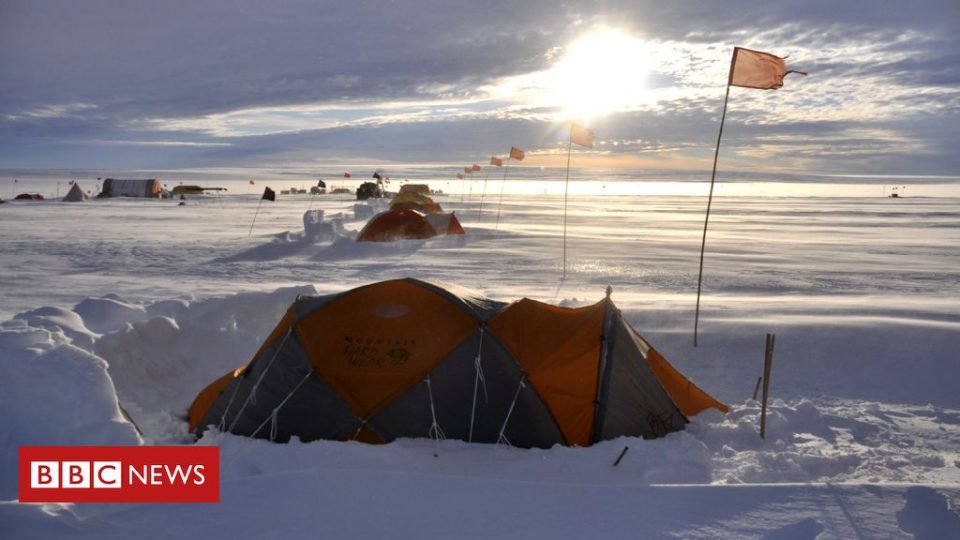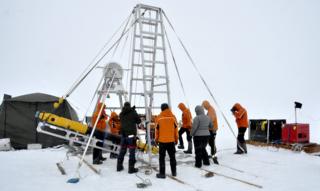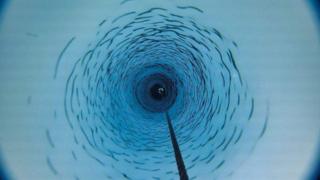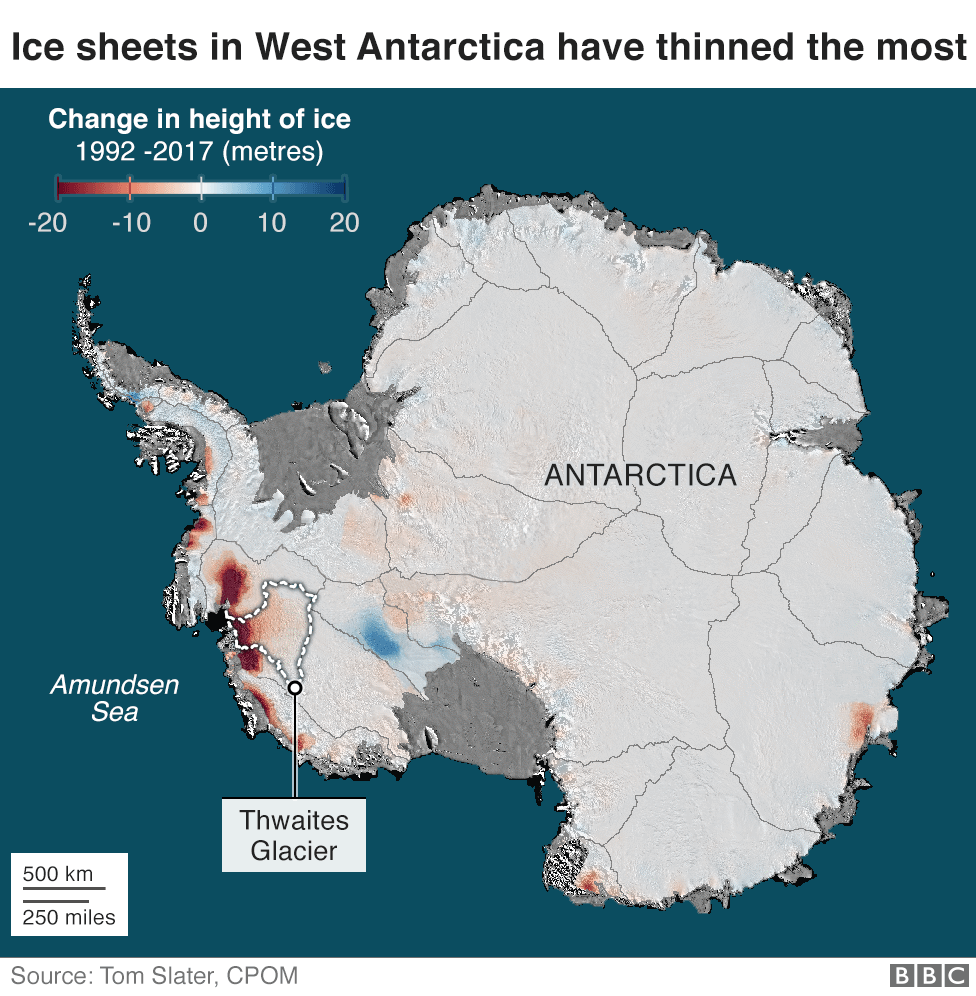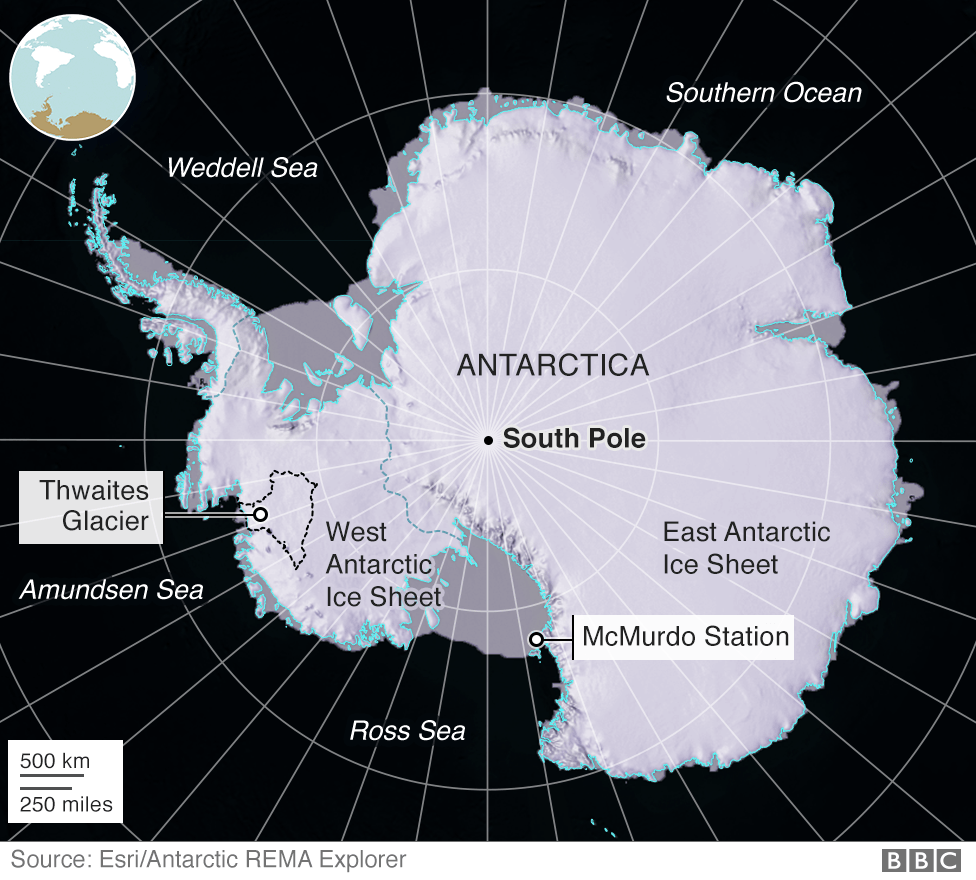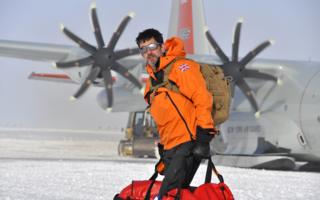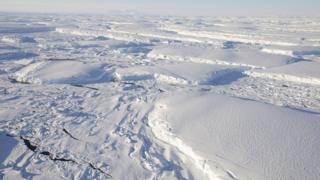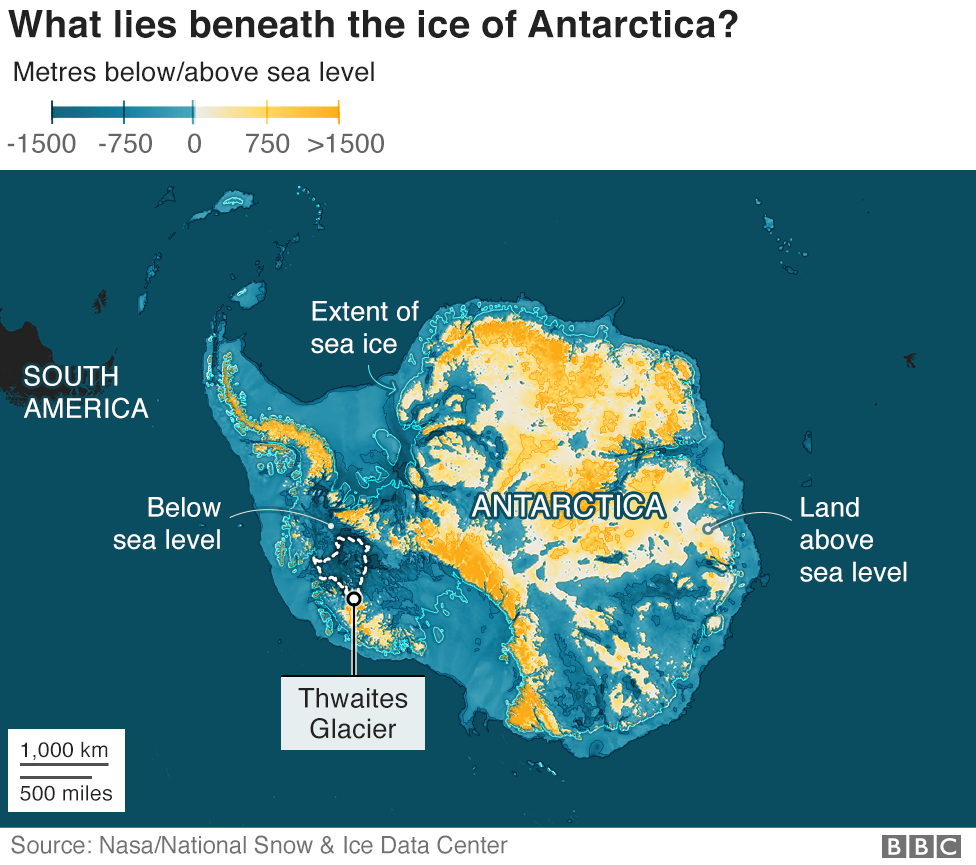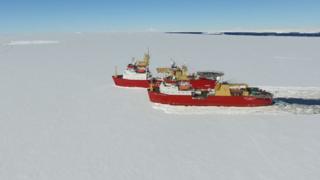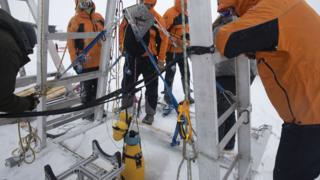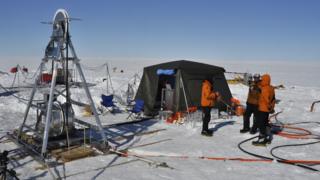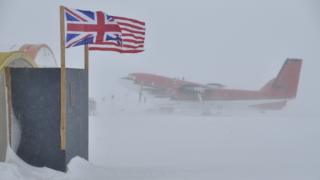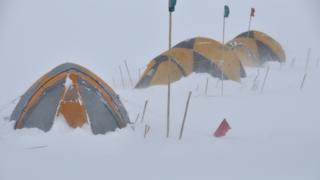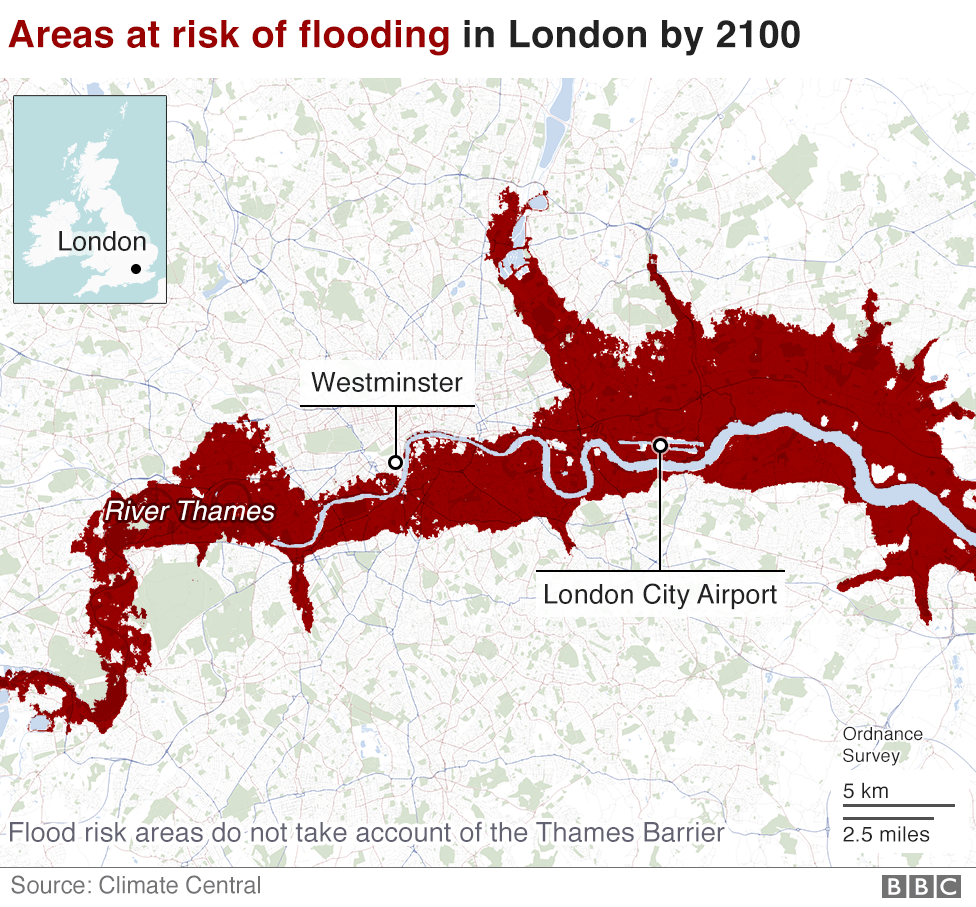The photos are dirty initially.
Sediment brushes up past the cam as Icefin, an intense yellow from another location run robotic submarine, relocates tentatively onward under the ice.
Then the waters start to clear.
Icefin is under virtually half a mile (600 m) of ice, at the front of one the fastest-changing huge glaciers in the globe.
Suddenly a darkness impends above, a looming high cliff of dirt-encrusted ice.
It does not resemble a lot, yet this is an one-of-a-kind picture – the very first photos from a frontier that is transforming our globe.
Icefin has actually gotten to the factor at which the cozy sea water fulfills the wall surface of ice at the front of the magnificent Thwaites glacier – the factor where this large body of ice starts to thaw.
Image copyright
British Antarctic Survey
The ‘end ofthe world’ glacier
Glaciologists have actually defined Thwaites as the “most important” glacier in the globe, the “riskiest” glacier, also the “doomsday” glacier.
It is enormous – about the dimension of Britain.
It currently makes up 4% of globe water level climb yearly – a substantial number for a solitary glacier – and satellite information reveal that it is melting progressively swiftly.
There suffices water secured in it to elevate globe water level by majority a metre.
And Thwaites rests like a keystone right in the centre of the West Antarctic Ice Sheet – a substantial container of ice which contains greater than 3m of added possible water level increase.
Yet, up until this year, no-one has actually tried a massive clinical study on the glacier.
The Icefin group, in addition to 40 or two various other researchers, belong to the International Thwaites Glacier Collaboration, a five-year, $50 m (₤38 m) joint UK-US initiative to comprehend why it is transforming so swiftly.
The job stands for the greatest and most intricate clinical area program in Antarctic background.
You might be amazed that so little is learnt about such a crucial glacier – I absolutely was when I was welcomed to cover the job of the group.
I swiftly uncover why as I attempt to arrive myself.
Snow on the ice path hold-ups my trip from New Zealand to McMurdo, the primary United States study terminal in Antarctica.
This is the initially of an entire brochure of hold-ups and disturbances.
It takes the scientific research groups weeks simply to obtain to their area camps.
At one phase, the whole period’s study gets on the factor of being terminated due to the fact that tornados quit all trips to West Antarctica from McMurdo for 17 successive days.
Why is Thwaites essential?
West Antarctica is the stormiest component of the globe’s stormiest continent.
And Thwaites is remote also by Antarctic requirements, greater than 1,000 miles (1,600 kilometres) from the nearby study terminal.
Only 4 individuals have actually ever before gotten on the front of the glacier prior to and they were the advancement event for this year’s job.
But recognizing what is occurring right here is important for researchers to be able to anticipate future water level increase properly.
The ice in Antarctica holds 90% of the globe’s fresh water, and 80% of that ice remains in the eastern component of the continent.
The ice in East Antarctica is thick – greater than a mile thick typically – yet it hinges on high ground and just slips sluggishly to the sea.
Some of it has actually been around for numerous years.
Western Antarctica, nevertheless, is extremely various. It is smaller sized yet still substantial, and is a lot more susceptible tochange
Unlike the eastern it does not hinge on high ground. In truth, basically the entire bed is way listed below water level. If it weren’t for the ice, it would certainly be deep sea with a couple of islands.
I’ve remained in Antarctica 5 weeks prior to I lastly board the red British Antarctic Survey Twin Otter that takes me to the front of the glacier.
I will certainly be camping with the group at what is called the basing area.
They are camped on the ice over the factor where the glacier fulfills the sea water, and have the most enthusiastic job of all.
They desire to pierce down with virtually half a mile of ice right at the factor where the glacier goes afloat.
No- one has actually ever before done that on a glacier this large and dynamic.
They will certainly utilize the opening to obtain accessibility to the sea water that is melting the glacier to discover where it is from and why it is striking the glacier so strongly.
They do not have long.
All the hold-ups imply there are simply a couple of weeks of the Antarctic summer season left prior to the weather condition begins to obtain actually negative.
As the participants of the exploration group established their devices, I assist with a seismic study of the bed underneath the glacier.
Dr Kiya Riverman, a glaciologist at the University of Oregon, drills down with an ice auger – a huge spiral stainless-steel drill little bit – and establishes little eruptive fees.
The remainder people dig openings in the ice for the “georods” and “geophones” – the digital ears that pay attention to the resemble of the blast that recovers from the bedrock with the layers of water and ice.
The factor the researchers are so stressed concerning Thwaites is as a result of that descending sloping submarine bed.
It implies the glacier obtains thicker and thicker as you go inland.
At its inmost factor, the base of the glacier is greater than a mile listed below water level and there is an additional mile of ice in addition to that.
What shows up to be occurring is that deep cozy sea water is moving to the coastline and down to the ice front, melting the glacier.
As the glacier hideaways back, yet much more ice is subjected.
It is a little bit like reducing pieces from the sharp end of a wedge of cheese.
The area of every one grows and larger – giving ever before much more ice for the water to thaw.
And that is not the just result.
Gravity implies ice desires to be level. As the front of the glacier thaws, the weight of the large storage tank of ice behind it presses onward.
It desires to “smoosh out,” discusses DrRiverman The greater the ice high cliff, she claims, the much more “smooshing” the glacier desires to do.
So, the much more the glacier thaws, the quicker the ice in it is most likely to circulation.
“The fear is these processes will just accelerate,” she claims. “It is a feedback loop, a vicious cycle.”
Doing scientific research of this range in such a severe atmosphere is not almost flying a couple of researchers to a remote place.
They require tonnes of expert devices and 10s of hundreds of litres of gas, in addition to outdoors tents and various other outdoor camping products and food.
I camped on the ice for a month, several of the researchers will certainly be available for much longer, 2 months or even more.
It took greater than a lots trips by the United States Antarctic program’s fleet of substantial ski-equipped Hercules freight airplanes simply to obtain the researchers and several of their freight to the job’s primary hosting article in the center of the West Antarctic Ice Sheet.
Then smaller sized airplanes – a senior Dakota and a number of Twin Otters – shuttled the individuals and products on to the area camps, numerous miles down the glacier in the direction of the sea.
The ranges are so terrific they required to established an additional camp midway down the glacier so the airplanes can refuel.
The British Antarctic Survey’s payment was an impressive overland journey that generated numerous tonnes of gas and freight.
Two ice-hardened ships anchored along with an ice high cliff at the foot of the Antarctic Peninsula throughout the last Antarctic summer season.
A group of chauffeurs in expert snow lorries after that dragged it greater than a thousand miles throughout the ice sheet with several of the most unwelcoming surface and weather condition in the world.
It was difficult going, the full throttle was simply 10 miles per hour.
Drilling with the ice
The researchers at the basing area camp strategy to utilize warm water to pierce their opening with the ice.
They demand 10,000 litres of water, which implies melting 10 tonnes of snow.
Everyone collections to deal with spades, hefting snow right into the “flubber” – a rubber container the dimension of a tiny pool.
“It’ll be the most southerly jacuzzi in the world,” jokes Paul Anker, a British Antarctic Survey exploration designer.
The concept is basic – you warm the water with a financial institution of central heating boilers to simply listed below boiling factor and after that spray it onto the ice, thawing your means down.
But piercing a 30 centimeters opening with virtually half a mile of ice at the front of the most remote glacier in the globe is hard.
The ice has to do with -25 C (-13 F) so the opening is accountable to freeze over and the entire procedure depends on the inconsistencies of the weather condition.
By very early January, the flubber is complete and all the devices prepares yet after that we obtain a caution that yet an additional tornado gets on its means.
Antarctic tornados can be extremely extreme. It is not uncommon to have cyclone pressure winds in addition to extremely reduced temperature levels.
This one is fairly moderate for Antarctica yet still entails 3 days of wind gusting up to 50 miles per hour. It strikes substantial drifts of snow right into the camp, overloading the devices, and all the job quits.
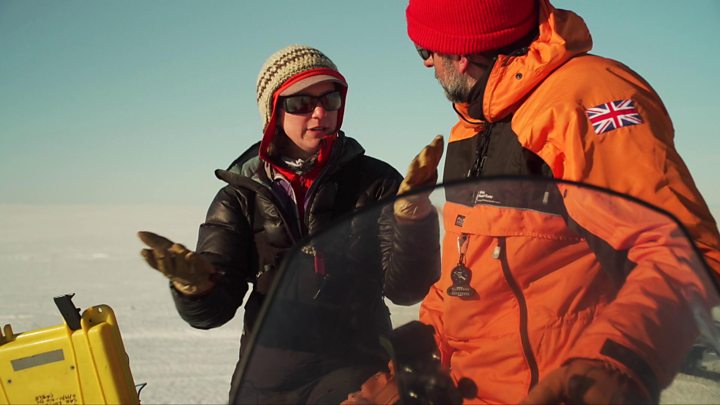
Media playback is in need of support on your gadget
We being in the mess camping tent playing cards and alcohol consumption tea and the researchers go over why the glacier is pulling away so swiftly.
They claim what is occurring right here is down to the intricate interaction of climate, weather condition and sea currents.
The trick is the cozy salt water, which comes from on the opposite side of the globe.
As the Gulf Stream cools down in between Greenland and Iceland, the water sinks.
This water is salted, that makes it fairly hefty, yet is still a level or more over cold.
This hefty salted water is lugged by a deep sea existing called the Atlantic conveyor all the means down to the southern Atlantic.
Shifting winds
Here it enters into the Antarctic Circumpolar Current, moving deep – a 3rd of a mile (530 m) – listed below a layer of much cooler water.
The surface area water in Antarctica is extremely chilly, simply over -2 C levels, the cold factor of seawater.
The deep cozy circumpolar water takes a trip all the means around the continent yet has actually been progressively intruding on the icy side of West Antarctica.
This is where our transforming climate is available in.
The researchers claim the Pacific Ocean is heating up and that is moving wind patterns off the coastline of West Antarctica, enabling the cozy deep water to well up over the continental rack.
“The deep Antarctic circumpolar water is only a handful of degrees warmer than the water above it – a degree or two above 0C – but that’s warm enough to light this glacier up,” claims David Holland, an oceanographer with New York University and among the lead researchers at the basing area camp.
I was intended to leave Antarctica at the end of December yet all the hold-ups imply the exploration just starts on 7 January.
That is when the satellite call originates from the United States Antarctic Program HQ in McMurdo.
We are informed we can not postpone our trips off the continent any kind of longer and need to leave on the supply airplane that schedules to get to the camp in a hr or two.
It is extremely aggravating to be compelled to leave previously the opening is ended up and the tools have actually been released, particularly provided for how long it took to obtain right here.
We claim our bye-byes and board the airplane.
I recall and see the wheel at the top of the drill switching, the black hose pipe spooling out gradually.
They are virtually half means down with the ice.
The airplane flies up over the camp and straight north, out in the direction of the sea.
The researchers had actually informed me that we had actually been camped on what is essentially a tiny bay of ice shielded by a horseshoe of elevated ground.
As we fly out over the front of the glacier, I become aware with a shock simply exactly how breakable a fingerhold it is.
There is no misinterpretation the legendary pressures at the office right here, gradually tearing, tearing and smashing the ice.
In some areas the terrific sheet of ice has actually separated totally, falling down right into an assortment of enormous icebergs which drift in intoxicated turmoil.
Elsewhere, there are high cliffs of ice, several of which rise virtually a mile from the sea bed.
The front of the glacier is virtually 100 miles broad (160 kilometres) and is falling down right into the sea at up to 2 miles (3km) a year.
The range is shocking and discusses why Thwaites is currently such a crucial part of globe water level increase, yet I am surprised to uncover there is an additional procedure that can increase its resort a lot more.

Media playback is in need of support on your gadget
Melt prices are raising
Most glaciers that move right into the sea have what is called an “ice pump”.
Sea water is salted and thick that makes it hefty. Melt water is fresh and as a result fairly light.
As the glacier thaws, the fresh water as a result has a tendency to circulation upwards, formulating the much heavier warmer sea water behind it.
When the sea water is chilly, this procedure is extremely slow-moving, the ice pump typically simply thaws a couple of lots centimetres a year – conveniently stabilized by the brand-new ice produced by dropping snow.
But cozy water changes the procedure, according to the researchers.
Evidence from various other glaciers reveals that if you boost the quantity of cozy water that is getting to the glacier the ice pump functions much quicker.
“It can set glaciers on fire,” claims Prof Holland, “increasing melt rates by as much as a hundred-fold.”
The little airplane takes us to the camp in the center of the West Antarctic Ice Sheet yet much more negative weather condition implies much more hold-ups and it is 9 days prior to a Hercules comes to take us back to McMurdo.
By after that we have actually been signed up with by several of the researchers.
It has actually been an extremely effective period.
They have actually verified that the deep circumpolar cozy water is obtaining under the glacier and have actually accumulated substantial quantities of information.
Icefin, the robotic submarine, has actually taken care of to make 5 goals, taking a host of dimensions in the water underneath the glacier and videotaping some remarkable photos.
It will certainly take years to procedure all the info the group has actually collected and integrate the searchings for right into the designs that are made use of to job future water level increase.
Rising water level
Thwaites is not going to disappear over night – the researchers claim it will certainly take years, potentially greater than a century.
But that must not make us contented.
A metre of water level increase might not appear a lot, especially when you take into consideration that in some areas the trend can climb and autumn by 3 or 4 metres each day.
But water level has a substantial result on the seriousness of tornado rises, claims Prof David Vaughan, the supervisor of scientific research at the British Antarctic Survey.
Take London.
An rise in water level of 50 centimeters would certainly imply the tornado that made use of to come every thousand years will certainly currently come every 100 years.
If you boost that to a metre then that millennial tornado is most likely to come when a years.
“When you think about it, we shouldn’t be surprised by any of this,” claims Prof Vaughan as we are preparing to board the airplane that will certainly take us back to New Zealand and after that house.
Ever- raising co2 degrees are placing a whole lot even more warm right into the ambience and the seas.
Heat is power, and power drives the weather condition and sea currents.
Increase the quantity of power in the system, he claims, and certainly large worldwide procedures are going tochange
“They already have in the Arctic,” claims Prof Vaughan with a sigh. “What we are seeing here in the Antarctic is just another huge system responding in its own way.”
Research and graphics by Alison Trowsdale, Becky Dale Lilly Huynh, Irene de laTorre Photographs by Jemma Cox and David Vaughan.
Additional study supplied by Professor Andrew Shepherd, Leeds University.


